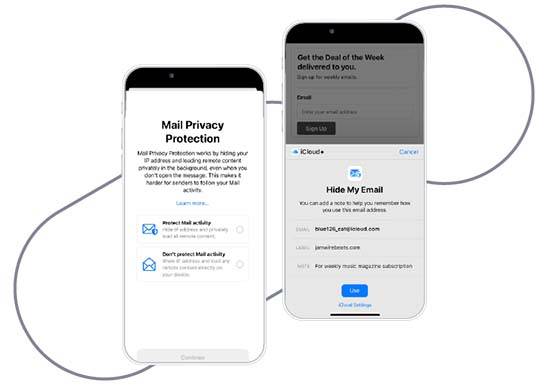- I. Mail Privacy Protection
- II. Private Relay
- III. Hide My Email
- How Apple iOS 15 Will Impact Your Email Marketing
- How to Prepare for the iOS 15 Update: 7 Tips
- Prepping for iOS 15 With Mobile Marketing Cloud
The only constant thing is change, and Apple has mastered it. To give users more control over their data, Apple has designed their iOS 15 update with privacy in mind. Three of these new features mean big changes for email marketers:
- Mail Privacy Protection
- Private Relay*
- Hide My Email*
*Private Relay and Hide My Email are included with iCloud+, a subscription that replaces Apple’s current iCloud storage plans.
While these features will only apply to users who opt-in, we predict most Apple users will elect to do just that, as roughly 96% of consumers opted to turn off tracking following Apple’s iOS 14 update.
Let’s take a look at each of these new privacy features and what they do.
I. Mail Privacy Protection
Mail Privacy Protection is a new feature that prohibits senders from using invisible pixels to gather information about Apple users who have chosen to opt into the changes. In addition, this feature prevents senders from collecting data about when or where an email is opened, including whether the recipient opens on mobile or desktop.
A “Mail Privacy Protection” tab will be located within the Mail app, enabling users to decide how much of their personal information (including IP address and location data) is shared with email senders.
- What this means: If you’re like most email marketers, you rely heavily on open rates to measure the effectiveness of your campaigns. Mail Privacy Protection means your data on email open rates or forwards will no longer be accurate.
Even if many of your customers favor desktop or Android, iPhones command over 41.7% of email client market share; moreover, 90.5% of all mobile email opens take place on an iPhone. Therefore, these changes could have a significant impact on your email marketing campaigns.
II. Private Relay
Private Relay encrypts web-browsing traffic (from users with subscriptions to iCloud+) and sends it through two separate internet relays. Instead of receiving a user’s actual location data, Apple’s proxy network will assign a random, region-specific code to mask a user’s IP address.
- What this means: You’ll no longer have access to location-based data or browsing activity to create user profiles or drive your email campaigns.
III. Hide My Email
This feature enables users with iCloud + subscriptions to create single-use email addresses connected to their personal email accounts. Hide My Email generates random email addresses that forward email to users’ personal inbox, especially handy for newsletter signups or web forms.
- What this means: Hide My Email will skew accurate deliverability for its users, as single-use email addresses keep customers’ personal email addresses private. They can also delete these addresses at any time. The result? A huge spike in bounce rates as Apple users unsubscribe from your email list en masse.

Source: Apple Newsroom
How Apple iOS 15 Will Impact Your Email Marketing
Let’s explore how these new developments will affect your email marketing campaigns and processes.
Derailed Campaigns and Workflows
If you have updates, campaigns, and marketing automation workflows that depend on open rates, they will take a huge hit. In addition, iOS 15 developments will report false positives, so you need to rethink measuring engagement among your subscribers.
In particular, you should reassess re-engagement automation that tracks subscriber engagement by open rates. In addition, segments divided by engagement levels (such as conditional splits by opens) will also need to change.
Email List Hygiene
Marketing emails sent to those who opt in to the new changes will show up in your database as “opened.” This can make users on your email list appear more engaged than they actually are. Consequently, more of your emails could end up tagged as spam, and more users may unsubscribe due to their inboxes' lack of relevant content.
How to Prepare for the iOS 15 Update: 7 Tips
How can you reduce the impact of Apple’s software update on your email marketing campaigns? Here are seven tips to get you started in the right direction.
- Audit your practices
- Provide value to your customers
- Split test your subject lines
- Remember segmentation
- Focus on tried-and-true automated email workflows
- Refocus on click-through rates (CTR)
- Go beyond email
1. Audit Your Practices
The most important first step? Audit your current practices.
See where you need to make changes regarding the data you rely on to measure the success of your email campaigns.
Make sure you update everyone on your team about the changes and proposed benchmarks.
Update your email marketing software settings to ensure triggers and split tests no longer depend on open rates.
As you won’t be able to rely on open rates to reflect the engagement levels of your list, make sure that you act on this data now. To protect your email list, identify your unengaged users and seek to either re-engage them or remove them from your list.
2. Provide Value
No amount of metrics can replace the value of quality content. If you’re not focused on preparing and disseminating content that your audience wants, all your efforts will ultimately be for naught.
3. Split Test Your Subject Lines
It’s crucial to A/B test as much as you can now. Gather all the data you need to best prepare for your post-iOS 15 campaigns and test variations in subject lines to see which ones perform best. Conduct a wide variety of tests on different styles and formulas, including:
- Length
- Emoji usage
- Popular formulas, such as the open-loop formula. Open a line of thought that your subscriber can only close by opening the email, e.g., “Why most small businesses fail in their first year.”
- Trending topics (e.g., the Olympics)
- Title case
- Figures
- Personalization
4. Remember Segmentation
Got segments? If you’re not segmenting your email marketing campaigns, now’s a good time to start. Use surveys to assess customer interests and determine which customers are disengaged or best left off your mailing list altogether. Maintaining good list hygiene is an email marketing best practice.
5. Focus on Tried-and-True Automated Email Workflows
As valuable as real-time metrics are, you can always rely on proven, well-established automated workflows. Automated workflows are email sequences automatically sent to subscribers based on their contact details or behavior. Here are four top workflows to try:
- Welcome sequence: Form a relationship with new subscribers and boost engagement with your brand.
- Abandoned cart sequence: Encourage shoppers to return to their carts and complete their purchases.
- Re-engagement sequence: Attempt to re-engage inactive subscribers and highlight the subscribers you should cull from your list. How do you measure engagement without open rates? Make ‘clicks’ your number one metric.
- Post-purchase sequence: Boosting cross-sells, up-sells, and referrals strengthen customer relationships.
6. Refocus on Click-Through Rates (CTR)
As stated above, you can still have complete control over your re-engagement automation by focusing on clicks rather than opens. As a measurement of how many people enjoy your email content, click-through rates are a key metric for measuring your impact on your audience.
As clicks are closer to conversions, CTRs are an even more meaningful engagement measurement than open rates. Luckily, this metric will be completely unaffected by the new Apple iOS 15 developments.
7. Go Beyond Email
With an average return on investment of $42 for every $1 spent, email marketing is one of the most effective marketing channels available.
However, if 85% of emails are opened on smartphones, how can you ensure that your content will still be seen on mobile after the Apple iOS 15 update? Targeting people on the channels they most frequently use on their smartphones could be a wise alternative.
For example, did you know that two billion people use WhatsApp each month? In addition, SMS boasts open rates of 98% compared to email. Incorporating these channels into your marketing efforts enables you to chart their effectiveness based on open rates, clicks, and conversions — just like email.
Prepping for iOS 15 With Mobile Marketing Cloud
If you feel overwhelmed by the new changes arriving with Apple’s iOS 15 update, you’re not alone. But the upheaval also offers marketers a prime opportunity to reassess outdated email-marketing practices and find new ways to engage their audiences.
Want to target your prospects and customers throughout their customer journey on mobile? Learn more about how to build effective omnichannel marketing campaigns with our Mobile Marketing Cloud.
Talk to one of our email marketing experts today!
